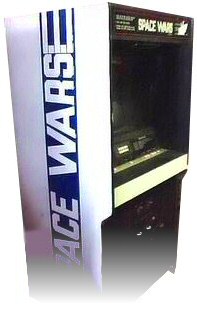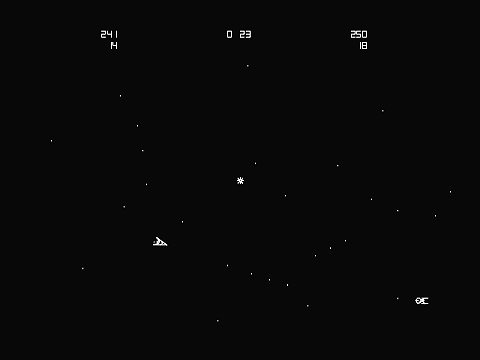 The Game: Two ships are locked in deadly deep-space combat, firing interplanetary ordnance at each other. Some variations include a sun whose gravity well will draw the immobile or the unwary to their destruction, or a roaming asteroid which can be a handy shield one moment and a killer obstacle the next. Whoever survives the most confrontations within a set amount of time is the victor. (Cinematronics, 1978)
The Game: Two ships are locked in deadly deep-space combat, firing interplanetary ordnance at each other. Some variations include a sun whose gravity well will draw the immobile or the unwary to their destruction, or a roaming asteroid which can be a handy shield one moment and a killer obstacle the next. Whoever survives the most confrontations within a set amount of time is the victor. (Cinematronics, 1978)
Memories: Packaged in a mammoth, industrial-fridge-sized cabinet, Space Wars may be imposing, but it’s hardly original. Larry Rosenthal, creator of the so-called “Vectorbeam” technology, picked a well-worn computer gaming icon that was fun, strategic…and in the public domain.
Originally programmed by Steve Russell on a massive, room-filling PDP-1 computer on the MIT campus in the 1960s, Spacewar was – like Willy Higginbotham’s Tennis For Two before it – an attempt to provide the public with an interactive display of computer power. The original Spacewar spread to a few other college campuses around the nation that had the necessary specialized computer hardware that could run it, and on one of those other campuses, this “demonstration” caught the eye of a student named Nolan Bushnell, who would later coin the idea of charging a quarter to play it. That strictly-raster-graphics iteration of Spacewar, retitled Computer Space, was packaged in one of the most elegantly sleek, unique arcade cabinets ever made…and it failed miserably. Bushnell couldn’t convince Nutting Associates, the company to whom he licensed his idea, to take another swipe at coin-operated video games. Bushnell had to start his own company to produce his second game, a far simpler sports game called Pong.
Cinematronics licensed Larry Rosenthal’s Vectorbeam display – providing a crisper, cleaner, sharper display that couldn’t be matched even by the processing and display technology available to arcade manufacturers in the day. Vectorbeam, also known as vector or X/Y graphics, was simple in theory: instead of a display system that had to scan every line of the monitor and account for every pixel, Vectorbeam simply fired an intense beam at a precisely-plotted point – or several beams – and it could even draw lines between those points, connect-the-dots style. The gun in the monitor didn’t have to fire as many electrons, so the display’s refresh rate was much higher, the picture much sharper (if sparser), and it seemed to be the wave of the future. Why not buy into Vectorbeam?
In hindsight, there was one very good reason: Rosenthal walked out on Cinematronics in a later dispute over game royalties, and set up a company called Vectorbeam, whose first coin-op was also very familiar – a slightly tweaked version of Space Wars called Space War. Cinematronics now had a pioneering display technology – and no documentation on how to implement it for future games. A new recruit, a young programmer named Tim Skelly, took on the thankless and bewildering task of reverse-engineering Rosenthal’s technology, and he eventually cracked it: according to Skelly, the first time he managed to draw a spaceship on a screen, he called the management. Cinematronics was so financially imperiled at this point, and Skelly’s work was so important to the company’s future, that everyone got dressed in the dead of night and drove down to the lab to see his work – including one employee who, Skelly famously claims, left his girlfriend in bed to see that spaceship.

Skelly later went on to create some great early vector graphics games such as Rip-Off, Warrior and Star Castle, but Rosenthal made a comeback of sorts too. Cinematronics sued Rosenthal for breach of his original contract, but the two parties settled out of court, with Rosenthal selling Vectorbeam (the company, and all of its attendant patents) to Cinematronics for $1,000,000. But their lock on the X/Y display technology was short-lived by the time of the 1979 settlement: Atari and Asteroids were about to make more money than Rosenthal made with his “settlement.” Tim Skelly later left for greener pastures himself, creating Reactor and the unorthodox (and ultimately unreleased) Screwloose for Gottlieb, and later going on to research user interfaces at Microsoft.
But the Cinematronics story all started with Space Wars – a game which points back not only to Nolan Buhsnell’s Computer Space, but to one of the very first video games ever. Not unlike those earlier games, Space Wars suffers somewhat from controls that may have been complicated enough to scare away casual players – and  managed to slip under the radar of a then-less-litigious Paramount Pictures despite giving player two a ship that bore more than a passing resemblance to a certain starship named Enterprise.
managed to slip under the radar of a then-less-litigious Paramount Pictures despite giving player two a ship that bore more than a passing resemblance to a certain starship named Enterprise.
